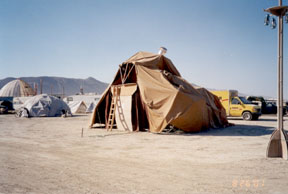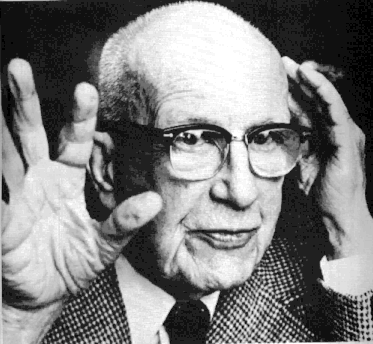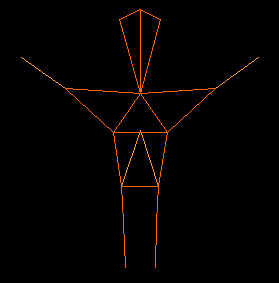
Desert Nose
The Desert Nose will be back at Burning Man 2002, providing
a cool place to chill-out amid the vast stimulation
of Burning Man. It's a place to shelter from the dust and
heat, get a view of Black Rock City and relax.
The Desert nose is a scaled up replica of Buckminster
Fuller's nose. It is 15 feet tall, 30 feet wide, 30
feet deep. It has a second floor deck which seats 600 lbs
of people. Inside the floor is carpeted and there is
enough custom bench-type seating for 25 people.
There is low volume "chill space" ambient and down tempo
music and at night there is low-level color lighting.
This year there is a new and improvised cooling system
that maximizes human coolage with a lot less wattage.
Also, there is an anwning over the deck area as a
precaution in case it rains, and as a sun shade.
The nose stereo has a new amplifier and there are new
nose lighting fixtures. The nose phone, which has become
infamous for its poor showing at last year's Burning Man
has been rebuilt, to its original specs, and is in great
working order. The septum is now covered in canvas
instead of wood, which was burned last year because
there was no space for it on the return trip.
But by far the biggest and most important change for
the nose this year is that it got a paint job! Each of
the nearly 320 struts (the awning adds several new struts)
has been painted with a sorting color in its middle,
and each end has been painted with three colored stripes.
All the struts which meet at a given vertex are painted
the same way, so it is easy to tell when a strut is
out of place. This will make assembly in the desert
much, much easier. In addition, each strut has a new
label which is much, much, much easier to read now, from
any orientation.
Last year I used an air compressor to spray water on
people and then blow air past them. The water on their
skin evaporated and they were quickly cooled. Very effective,
but nosiy and it consumed a lot of power.
The one resource in abundance at Burning Man is
human energy. So, this year's cooling system taps some of
that. We'll be using hand-pumped sprayers to mist people.
These hold 2.5 gallons each and last a while after being
pumped up.
To move air this year I'm using an electric fan
bolted to the underside of the deck pointing down.
This will move a lot more air than the compressor,
and will be easier for people to control for themselves.
It will also move air inside the nose and that will
help cool the nose somewhat too.
The fan will run on electric power, assuming
we're in center camp, where there is some 110v power.
If the camp is on the Esplanade we may use a generator,
or I could run the fan with 50 square feet of solar
cells...
Why build a replica of Buckminster Fuller's nose?
Well, it all started a couple of years ago...
I got the idea while I was driving back from
Burning Man 2000 and
reflecting on what worked and what didn't work
with my dome. It seemed that the wind blew
in too much from the sides. Also, I wanted a door.
Doors don't work well in domes -- they get weakened
by adding a door. To make a door in a dome I figured
I could make a stong "hoop" and enclose a door,
or make a strong column and put a door on each
side of it. When I imagined the latter -- a dome
with two rounding doors side-by-side -- I immediately
thought of a nose. The more I thought about it the
more I liked the idea.
I wondered how I might build one and decided that the
same technology used to build the dome could also work
for the nose. And, if the nose was to be built as a
geodesic structure it would be perhaps appropriate to
build it based on Buckminster Fuller's nose. While he
didn't actually invent the concepts of geodesic
structures, he certainly developed and popularized them.
I also feel personally aligned with one of his primary
beliefs: that humans have advanced to the point where we
have the "option to succeed" and the ability to raise the
standard of living for everybody on the planet.

For more on Buckminster Fuller and his remarkable
accomplishments, viewpoints and life check out these
resources:
I decided to start by building a model.
I built the model out of copper ground wire, which
I soldered together. The nose would lay on the ground
with the nostrils pointing away from the prevailing
wind. I actually built only half of the model with all
its struts. The other half just had a few large curved
wires to suggest the entire shape.
Then I labeled all the vertexes and all the struts.
Some vertexes and struts were exactly on the center line,
so there was only one of each. The rest there would have
a left and right version (which would be identical).
Then I very carefully measured the X, Y and Z coordinates
of each vertex and created a
data file
which contained the coordinates for each vertex number.
I also surveyed the model to determine which two vertexes
were connected by each numbered strut. I recorded this
information in another
data file
which listed the two vertex
numbers for each strut number, and whether the
strut was on the center line or not.
Then I created a program
using Perl which analyzed the
two input files for various purposes, including:
- Applying a scaling factor to the data to let me
see how big the nostril openings would be compared
to the entire length, width and height.
- Calculating the actual length of each strut.
- Generating labels to be applied to each strut to
identify it.
- Determining the order in which to cut struts to
minimize wasted electrical conduit.
Here is a makefile that shows lots of examples of using the vert2.pl program:
makefile
To use the program and the makefile you will have to download them and rename them. The files in my web site are vert2.txt and makefile.txt. They need to be renamed vert2.pl and makefile respectively. And, you will have to make vert2.pl executable. There is a perl and make available for pretty much all computers. If you are on Linux or a mac this should be pretty straightforward. If you're on a PC, get a mac. Alternatively, you can get perl for your PC and I'm sure there is a port of make somewhere that will work for you.
Also, the vert2.pl program expects the module GD to be available so it can produce GIF images. If you don't have GD and can't figure out how to get it, then comment out the line that says "use GD;" by inserting a sharp character in front of it (#). The program will work, but you won't be able to generate images.
This program accepts two data files from
you and then generates data and images for them. It
assumes you will be building a structure with a center
line of symmetry.
In fact, the finished version will have 311 struts,
ranging in length from less than 11" to over 12' (for
some side stabilizing struts that lay on the ground).
Nose Width=21' 10 and 5/8"
Nose Length=25' 6"
Nose Height=14' 7 and 3/32"
Door Height=8' 5 and 1/8"
Deck Height=8' 0 and 7/8"
|
Look who was lurking among the struts of the Desert Nose...

Struts 4, 5 ,6, 7, 11, 13, 14, 15, 16, 17, 18, 19 and 91
of the Desert Nose
|